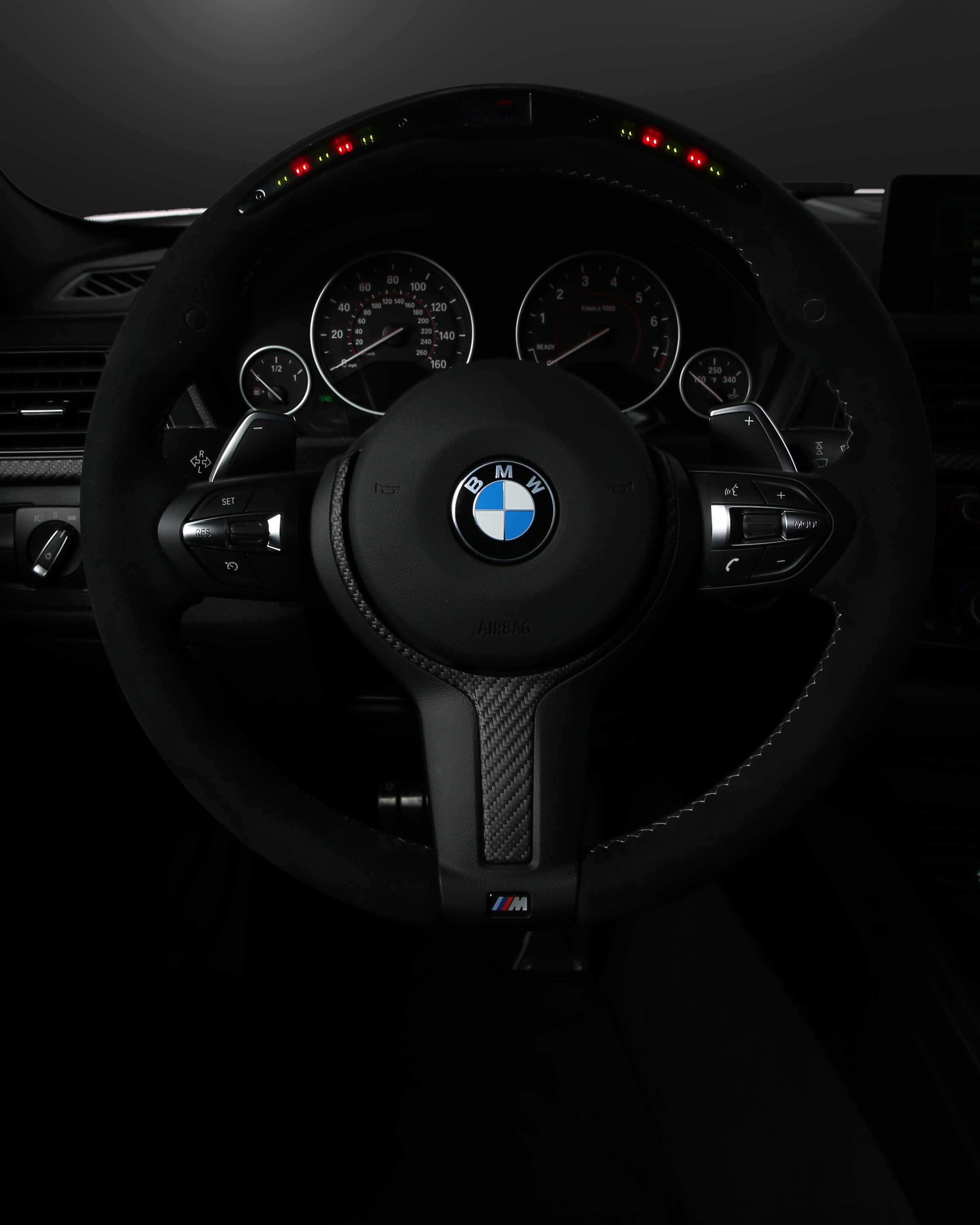Parallel parking is a skill that many new drivers have a hard time accomplishing smoothly (and many older drivers too). A great deal of entertainment has been had at the expense of a driver getting totally befuddled while attempting to parallel park. But now, manufacturers, are building cars that will parallel park themselves.
A perky TV reporter exited from a Ford Escape at the Kansas City Auto Show after doing a ride-along on a parallel self-parking demonstration. She was accosted by your humble scrivener and asked, rhetorically, if she knew what the enabling technology for what she just witnessed was. It’s electric power steering (as well as a bunch of lines of code and some rugged computer hardware). It can’t be done with a standard hydraulic steering gear or a manual steering gear; it’s the electrically assisted steering rack that allows the vehicle to steer itself. Scary, isn’t it. And think about all of those lines of code that enable inter operation between vehicle subsystems (ECU, transmission, ABS, park sensors, and power steering, among others).
But self-parking is merely icing on the cake for what electrically assisted power steering brings to manufacturers. Primarily, electric power steering is used because of its positive contribution to fuel economy. The passenger car fleet average MPG (an average for all of a manufacturer’s passenger cars) is supposed to be 39.5 by 2016 in order to avoid fines from the EPA.
In Europe, carbon dioxide levels are also regulated and, like MPG, benefit from smaller engines, lower weight and minimal fuel consumption. That is why we see direct injection and turbochargers on small displacement engines. These standards are tough and they are getting tougher for manufacturers to meet. So an up to a one MPG fuel consumption savings by adapting electric power steering makes corporate sense.
However, if you ask the enthusiast, they’ll tell you electric power steering is terrible. It has no ‘tactile’ feel up into the hands. And that’s true, there are some terrible electric power steering implementations. The question is, what prevents electrically assisted power steering from delivering good steering feel. And the answer is pretty convoluted, unfortunately. But a good place to start is at the beginning.
The steering wheel is used to turn the front wheels (with rare exceptions – think forklifts and combines) from side to side. The steering ratio is an expression of the number of degrees the steering wheel has to be turned to turn the wheels one degree. For instance, the steering ratio 16:1 means the steering wheel has to be moved off center by 16 degrees of rotation to turn the wheels 1 degree. The lower the ratio, the ‘quicker’ the steering.
The total steering deflection (the total number of degrees the wheels can be turned from one extreme to the other) times the steering ratio divided by 360 (a complete circle) will give the turns of the steering wheel ‘lock to lock’. But just because a car has fewer turns ‘lock to lock’ doesn’t mean its steering is necessarily quicker. It may mean that its wheels cannot be deflected as far as another’s, a trait of front wheel drive cars for instance.
So those are some of the basic parameters that are used when talking about steering. The closer the ratio is to 1:1 the harder the car will be to steer without some assistance. In fact older heavy cars relied on big ratios (20:1 +) and large diameter steering wheels (to multiply the leverage the driver delivers) to make the steering manageable. Think of the steering effort needed to turn a 1965 Chevy Impala station wagon without power steering and you understand why the driver had to really crank the wheel to get the tires to turn and it looked like the steering wheel had been stolen from the pilothouse of a Mississippi river steamboat.
Steering gears can be divided into two basic types, Pitman arms and rack & pinion. Pitman arm steering gears include worm & sector, worm & roller, worm & nut (also known as recirculating ball), and cam & lever. They rely on a worm gear at the end of the steering column to move a Pitman arm. The worm gear would operate a sector gear, a roller, a ‘nut’, or a lever, which ‘twisted’ the Pitman arm. Pitman arm type steering gears are rarely used in modern passenger cars (but the recirculating ball variant was used heavily in cars in the recent past).
The knock on Pitman arm steering gears was that they tended to have a bit too much lash (otherwise called ‘slop’) and for enthusiasts, something with better ‘feel’ was desired. Rack and pinion steering was the answer.
Rack and pinion steering is a pinion gear attached to the end of the steering column that moves a rack (a shaft with gear teeth cut along the length of the shaft). There is less slop and fewer linkages in a rack and pinion steering unit but also less mechanical leverage than a recirculating ball steering gear. But the tactile feel that a good manual steering rack feeds back into the driver’s hands is what enthusiasts crave.
And a manual rack is the ticket up to about 1000 kilograms (2200 pounds). The heavier the vehicle the less ‘quick’ the steering ratio could be and still maintain reasonable steering effort. So, manual racks were replaced by power assisted rack & pinion steering once cars started getting significantly heftier.
The power assist was via hydraulic pressure that exerted it’s force, in both directions, on a piston enclosed in a cylinder attached to the steering rack. The amount of assist was controlled by a complex valve setup attached to the pinion. The power steering pump was attached as an accessory drive from the engine. The pressure had to be specially regulated given the fact that it would otherwise vary greatly depending on engine RPM.
As good as some hydraulically assisted power steering racks are, others are, and were, pretty bad. Depending on the manufacturer’s desires, racks could be isolated by softer mounts, the rack mounting location could be compromised, suspension geometry could be slanted towards minimal feedback, and/or inferior tires could be specified. In other words, you can remove feel from a steering rack.
But the question is not why hydraulically assisted steering racks feel good and electrically assisted racks not. It’s the wrong question. The question should be, when will an electrically assisted rack feel as good as the better hydraulically assisted racks. And the answer is that they will, eventually. However, truth be told, not all electrically assisted racks will.
ZF makes a number of electrically assisted steering racks under its Servolectric range. And a sampling of their competitors shows a similar set of technologies employed in a variety of electrically assisted steering racks.
There are three basic types of electrically assisted racks, column mounted assist, second-pinion assist, and rack drive assist. Of the three, the column mounted assist is the least likely to provide good ‘tactile’ feedback. It employs a power assist unit mounted on the steering column, usually in the interior of the car. This type of electrically assisted power steering rack is more likely to show up on smaller and less expensive cars. The assist motor is mounted on the steering column, smack dab in between your hands and the steering rack.
Further, the steering column, below the assist motor, has to be strengthened to handle the additional torque the assist motor provides. It’s not an easy recipe for providing good steering feel. Unfortunately, this is a very common solution at the low end of the market. Further, because these cars are price sensitive, the other components that can effect steering have probably been optimized for cost over feel.
The type of electrically assisted steering rack that holds the most promise for steering feel is the rack drive assist. ZF makes a very nice rack drive assist rack called, ZF Servolectric/Paraxial. This is the electrically assisted steering rack solution that an enthusiast will eventually look for. In this solution, there is a straight connection between the steering wheel and the rack.
The assist unit is mounted in parallel to the end of the rack away from the pinion and provides assist through a toothed belt and a recirculating ball gear (hmmm, everything old is new again). One telling line in ZF’s product paper is the following, “[t]he low noise generation of the recirculating ball gear allows rigid connection of the steering gear to the subframe of the vehicle, which gives a very direct steering feel.”
From an illustration in the ZF material: “To transform the rotational movement of the electric motor into a linear movement of the steering rack (1), ZF Servolectric with paraxial drive uses a drive concept consisting of toothed- belt drive (2, 3, 4) and recirculating ball gear (5, 6, 7). Both drive stages work with a very high efficiency.
The recirculating ball gear is a system in which the ball chain (7) is returned through a channel (6) integrated in the ball recirculating nut (5).”
So there’s reason to hope that an electric rack drive assist can deliver good steering feel. But there is a lot of tuning involved. Remember that hydraulically assisted steering racks used a valve setup to regulate the amount of assist. In an electrically assisted steering rack that is accomplished with software. A lot of software. And a lot of parameters which can be changed in that software.
Huibert Mees, Chassis Fellow for Tesla Motors, commented to BMWblog at this year’s NAIAS, that there are over 500 parameters that can be set over various operating modes and driving conditions of the electrically assisted rack. That can take some time to sort out even if sorting it out can be done on the fly, unlike recutting an appropriate valve setup for a hydraulically assisted rack. There was an interesting blog post on tuning an electrically assisted rack ‘on the fly’ at PickupTrucks.com that’s worth a read: http://news.pickuptrucks.com/2010/05/driving-a-pickup-with-electric-power-steering.html
While there is hope that we will get decent feel from the best of the electrically assisted racks, it may take time to sort through all of the parameters to find a sweet spot. And remember, tires, suspension geometry, and the quality of other components in the chain can and will effect steering feel. One space to watch, to see if some gearheads will buy into using electrically assisted steering racks, is the upcoming F10 version of the M5. If it doesn’t use an electrically assisted rack, like its 5 series siblings do, then we can conclude that electrically assisted power steering racks are not ready for prime time . . . yet.
While I haven’t learned to love electric power steering, my worrying has subsided. There’s no getting around the fact that manufacturers are scrambling for every tenth of a gallon they can save to apply towards the coming fuel economy and emissions standards. The trick for an enthusiast will be finding a manufacturer that still cares about them. Good steering feel can be delivered in an electric steering rack, but it won’t be at the bottom end of the market.
And why does the title reference a Dr. Lanchester, rather than Dr. Strangelove? Dr. Lanchester was an English engineer and inventor who is pretty much under appreciated these days. He worked in the very early years of the automotive industry and contributed a lot to it. He also took out a patent on a power steering assist system in 1902. http://en.wikipedia.org/wiki/Frederick_W._Lanchester





































































